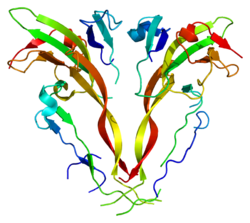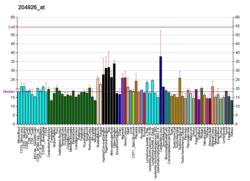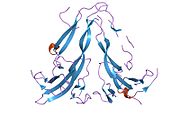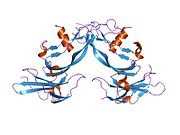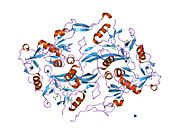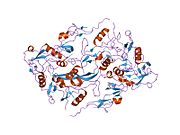INHBA
Inhibin, beta A, also known as INHBA, is a protein which in humans is encoded by the INHBA gene.[5] INHBA is a subunit of both activin and inhibin, two closely related glycoproteins with opposing biological effects.
Function
The inhibin beta A subunit joins the alpha subunit to form a pituitary FSH secretion inhibitor. Inhibin has been shown to regulate gonadal stromal cell proliferation negatively and to have tumor-suppressor activity. In addition, serum levels of inhibin have been shown to reflect the size of granulosa-cell tumors and can therefore be used as a marker for primary as well as recurrent disease. Because expression in gonadal and various extragonadal tissues may vary severalfold in a tissue-specific fashion, it is proposed that inhibin may be both a growth/differentiation factor and a hormone. Furthermore, the beta A subunit forms a homodimer, activin A, and also joins with a beta B subunit to form a heterodimer, activin AB, both of which stimulate FSH secretion. Finally, it has been shown that the beta A subunit mRNA is identical to the erythroid differentiation factor subunit mRNA and that only one gene for this mRNA exists in the human genome.[6]
Interactions
INHBA has been shown to interact with ACVR2A.[7][8]
References
- ^ a b c GRCh38: Ensembl release 89: ENSG00000122641 – Ensembl, May 2017
- ^ a b c GRCm38: Ensembl release 89: ENSMUSG00000041324 – Ensembl, May 2017
- ^ "Human PubMed Reference:". National Center for Biotechnology Information, U.S. National Library of Medicine.
- ^ "Mouse PubMed Reference:". National Center for Biotechnology Information, U.S. National Library of Medicine.
- ^ Burger HG, Igarashi M (April 1988). "Inhibin: definition and nomenclature, including related substances". Endocrinology. 122 (4): 1701–2. doi:10.1210/endo-122-4-1701. PMID 3345731.
- ^ "Entrez Gene: INHBA inhibin, beta A (activin A, activin AB alpha polypeptide)".
- ^ Lewis, K A; Gray P C; Blount A L; MacConell L A; Wiater E; Bilezikjian L M; Vale W (March 2000). "Betaglycan binds inhibin and can mediate functional antagonism of activin signalling". Nature. 404 (6776). ENGLAND: 411–4. doi:10.1038/35006129. ISSN 0028-0836. PMID 10746731.
{{cite journal}}: Cite has empty unknown parameters:|laydate=,|laysource=, and|laysummary=(help) - ^ Martens, J W; de Winter J P; Timmerman M A; McLuskey A; van Schaik R H; Themmen A P; de Jong F H (July 1997). "Inhibin interferes with activin signaling at the level of the activin receptor complex in Chinese hamster ovary cells". Endocrinology. 138 (7). UNITED STATES: 2928–36. doi:10.1210/endo.138.7.5250. ISSN 0013-7227. PMID 9202237.
{{cite journal}}: Cite has empty unknown parameters:|laydate=,|laysource=, and|laysummary=(help)

